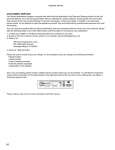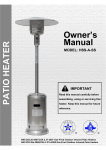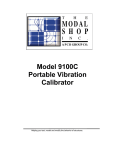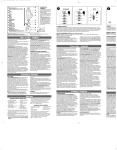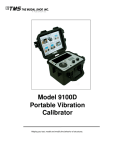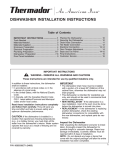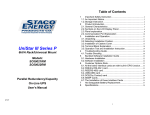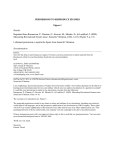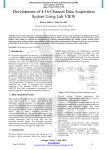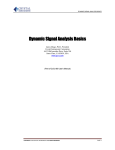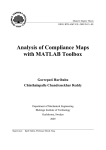Download Modal Testing Excitation Guidelines
Transcript
Modal Testing Excitation Guidelines Marco A. Peres and Richard W. Bono, The Modal Shop, Inc., Cincinnati, Ohio Electrodynamic shakers or exciters are commonly used in experimental modal analysis. The practical aspects regarding the setup of the shakers, stingers and transducers are often the source of test difficulties and avoidable measurement errors. This article reviews the basics of shakers as beneficial to modal testing and common problems associated with setup issues and resulting measurement errors. These include shaker alignment, sensor considerations, stinger selection, amplifiers, reciprocity assumptions and other test-related circumstances. A system setup for modal testing includes several measurement and test components around the structure under test itself. Typically one or more electrodynamic shakers (also called modal exciters) are employed to provide a known excitation input force to the structure. Dynamic transducers are used to measure the input excitation force and the resulting vibration responses. Once data are acquired, the resulting frequency response functions (FRFs) obtained by the data acquisition system are stored for post processing calculations, data reduction, curve fitting, and mode extraction. Figure 1 offers a simple representation of the main instrumentation components found in a modal test setup. Multichannel dynamic signal analyzers (DSAs) are required to acquire data. Many of today’s DSAs have 24-bit A/D (analog to digital) converters with built-in signal conditioning (ICP® or IEPE inputs) and built-in source channels (signal generator) to drive the shaker system and provide mechanical excitation to the structure. Advanced modal software incorporates robust geometry-driven data acquisition wizards, analysis methods and algorithms. What was extremely difficult or almost an art many years ago, has been greatly simplified for easier and faster modal testing. In addition to all the recent advancements on the analysis side, new methods and algorithms for modal parameter extractions, the challenges of acquiring good data for experimental modal analysis are still very real. The old adage “garbage in, garbage out” becomes more present than ever if care and attention are not paid to some of the basic practical aspects behind test setups. And as another old saying goes, a chain is no stronger than its weakest link. So in a forced input modal test system, special attention must be paid to the excitation setup to ensure good quality data and representative results, especially considering that it is the reference measurement used in the processing of FRFs. Accordingly, it is critical to understand the practical aspects of shaker setup for modal testing measurements with respect to the force sensor, the modal exciter and the power amplifier. Obtaining Valid Measurements Sensor Selection. Piezoelectric force sensors and piezoelectric impedance heads are the two most common transducers used for measuring input forces. An impedance head is nothing more than a transducer that measures both force and resulting driving point response in one device. Today, an impedance head is typically an accelerometer and force transducer built together, but it was originally based on a velocity transducer and force transducer. (This is where the name impedance head comes from and has lingered on today even though velocity is not normally measured.) This is a critical measurement in experimental modal analysis, and it is recommended that impedance heads be used in most cases. A combination of a separate force transducer and accelerometer mounted next to each other is often used instead, but the convenience and accuracy of measuring the driving point excitation with a single transducer and validating reciprocity between input locations is best obtained with an impedance head.1 A force transducer with sensitivities in the range of 11 to 22 Based on SAE paper 2011-01-1652 presented at the 2011 Noise and Vibration Conference, Grand Rapids, MI, May 2011. Copyright © 2011 SAE International. 8 SOUND & VIBRATION/NOVEMBER 2011 Figure 1. Typical modal test setup. Figure 2. Force transducer (shown installed on modal stinger). mV/N (50 to 100 mV/lbf) allows forces up to ±445 N (±100 lbf) to be measured; typically more than enough force range for most modal application scenarios. Also available are impedance head transducers with TEDS (transducer electronic data sheet) capability as described by the IEEE 1451.4 standard.2 The built-in memory available on TEDS transducers stores sensor calibration information and specifications allowing plug-and-play functionality when the sensor is connected to the data acquisition system. This simplifies system setup and minimizes chances of human error due to entering incorrect sensitivity values when setting up the channels. Sensor Mounting Considerations. A very important consideration when mounting force transducers is recognizing that the typical force transducers used are “uni-directional.” This means two things: first, that force transducers are designed to accurately measure force on only one of its two mounting faces, for example labeled “top” and “base” as seen on Figure 2. This is due to the fact that the force transducer itself has mass and stiffness. They are designed and calibrated to read force accurately on one of its mounting faces so they need to be installed accordingly. Note that, for this model force transducer, the “top” of the unit is the designed sensing surface and should be mounted directly to the test article. Some impedance head transducers have an indication of exactly which side to mount to the structure. In any case, it is always a good idea to refer to the transducer’s user manual for identifying which mounting surface is intended to measure the force accurately. Secondly, because the sensor measures force in only one direction, a stinger is used to reduce any possible side loads that may be transmitted. Note that this piezoelectric force sensor is mounted to a thin rod-style stinger that is stiff in the axial direction and flexible in the lateral direction. (This is detailed later in this article.) Another important consideration is that the force transducer should always be mounted directly to the test structure, between it and the stinger and shaker assembly. If the force gage is mounted on the exciter side, as shown in the illustration in Figure 3, then the dynamics of the stinger become part of the measured function. (This is generally only an issue when using a conventional shaker for modal applications; modal shakers, as we will see later, have www.SandV.com Figure 5. Section view of generic electrodynamic shaker. Figure 3. Typical stinger setup showing proper force transducer location relative to test article, threaded stinger rod, and exciter. Left configuration shows correct way of mounting force sensor next to structure (force gage “divorces” the stinger/shaker from the structure) as opposed to mounting the sensor on shaker/exciter side, where the stinger becomes part of test structure. Figure 6. Electromagnetic force equation of conductor immersed in magnetic field; F = electromagnetic force, L = length of conductor, I = current vector, B = magnetic field vector. Figure 4. Impedance head mounted in skewed orientation to test structure. a through-hole armature design and would not allow the force transducer to be mounted incorrectly). The force transducer is usually mounted using a threaded adhesive mounting base (Figure 4) firmly attached to the test structure using dental cement, two-part quick epoxy, or a cyanoacrylate type adhesive (Super Glue or Loctite®). Often a piece of foil adhesive tape is first applied to protect the surface of the test article, with the mounting pad bonded to the tape. Dental cement is ideal because it is extremely stiff, providing rigid attachment within the frequency range of typical modal testing. If the test structure can be drilled and tapped with an appropriate thread, directly attaching the force transducer to the structure is the best solution. Electrodynamic Shakers Principle of Operation. A shaker (or exciter) is an electrodynamic transducer consisting of a voice coil attached to a moving armature, and a magnet structure with a small gap in which the voice coil moves (see Figures 5 and 6). The magnet structure is designed to provide a strong magnetic field across the gap, so when the current flows in the voice coil it will experience a force dependent on the strength of the current and the magnetic field. Small shakers www.SandV.com (with sine peak force capability below 500 N or 100 lbf) – or most modal shakers in the market today – typically use high-strength permanent magnets. Larger shakers use electromagnets instead (field coils). An alternating electric current in the voice coil causes the shaker to move forward and backwards in the magnetic field, causing the armature and the test article to vibrate accordingly to a certain input signal. Several different magnet systems have been used in electrodynamic exciters. They typically consist of a cast magnet of a special magnetic alloy or a ceramic material. In general the greater the magnetic flux, the greater the efficiency of the shaker. Al-Ni-Co magnets (an alloy of aluminum, nickel, and cobalt) became available in the early 1930s and have been used in electrodynamic shakers until the 1980s. In the mid ’80s rare-earth magnets became available, and almost all modern shaker designs benefit from neodymium magnets (based on an alloy of the rare earth metal neodymium, iron, and boron). These magnets are about four times stronger than Al-Ni-Co magnets for a given size, which offers a great benefit for shaker performance and usability. Modern shakers can deliver forces more efficiently and can be constructed much lighter than previously. Shaker manufacturers have been able to achieve up to a 67% reduction in weight, enabling truly “one-man” handling for the exciter. In summary, new lightweight shakers are easier to handle and fixture during installation, especially when the test engineer needs to move the shaker around and try different excitation points. This is very common in large-channel-count modal tests. Shaker Quantity and Force Requirements. The question on how many shakers are required by a certain modal test is often hard to answer. Often test systems are limited by the total number of output sources in the data acquisition system or shakers available SOUND & VIBRATION/NOVEMBER 2011 9 in the test lab for modal testing. Usually two to four shakers are sufficient for most tests, particularly when testing larger structures like automobiles or aircraft. Generally, tests with more than five shakers are rare. Ultimately, there need to be enough shakers acting as reference locations that are positioned so that the modes of interest of the structure are adequately excited and observed, and good frequency response measurements are obtained. This includes having multiple shaker/reference locations to resolve repeated roots and/or closely spaced modes. The excitation levels for modal testing are usually reasonably low. There is no need to provide large force levels for conducting a modal test especially if appropriate response transducers (accelerometers) are selected with good sensitivity and resolution, as well as high quality, high resolution (24-bit technology is fairly standard in today’s commercial offerings) data acquisition systems. The level only needs to be sufficient enough to make good measurements. In fact, larger force levels tend to overdrive the structure, exciting nonlinear characteristics of the structure and providing poorer overall measurements than with lower level force tests. For this reason, again, on larger structures, it is often desirable to use multiple shakers at lower force levels to more evenly distribute force than a few single shakers operating at high level forces. Through-Hole Armature Design. Conventional vibration testing uses a shaker with a traditional mounting platform or table design; the test article is directly attached to the top surface of the armature with some base excitation applied, usually monitored by controlling some prescribed acceleration. The device under test (DUT) is normally subjected to some operating environment, generic spectrum or some excessive environment to determine if the equipment is suitable for the intended service. In the early days of modal testing with shaker excitation, smaller shakers were used to apply some low-level excitation to be able to measure a frequency response function. Usually the shaker was attached with a long rod, commonly referred to as a stinger or quill, to impart force to the structure. (The purpose of the stinger was to dynamically decouple the shaker from the structure.) Because these traditional shakers were typically used for base excitation, the armature attachment configuration was not optimal. Usually, some type of left-right thread arrangement was made or some type of collar was designed to enable an easier attachment to the shaker. It was a rather difficult arrangement no matter how the connection was made, given a threaded interface on both attachment ends. In addition, there had to be some thought given to shaker position and actual length of stinger needed. If a different length stinger was needed, then the shaker needed to be reoriented and realigned, or different stinger lengths were used for the modal test. Overall, the setup of the traditional shaker for a modal test was very difficult and cumbersome. Due to all these problems, specific design configurations better suited for modal testing applications were developed. In the late 1980s, ideas from the University of Cincinnati’s Structural Dynamics Research Laboratory gave rise to the through-hole armature with a chuck-and-collet design (like gripping a drill bit on a hand drill) that enabled very easy adjustment and attachment of the shaker to the modal test article as shown in Figure 7. A long stinger can slide into the shaker’s through-hole armature, threaded to the force transducer attached to the test article, be properly aligned, and then clamped down with the chuck and collet at the appropriate length. These components are shown as an exploded view in Figure 8, and a video demonstrating actual installment is available on the Internet.3 This design also easily accommodates stingers of different lengths if needed, and the arrangement is so simple that it is difficult to imagine having to set up the test without this important feature. Through-hole armature design with a chuck-and-collet stinger attachment makes test setup so much easier that the term modal shaker usually refers specifically to a shaker that comes with a through-hole armature (as opposed to a traditional platform/table shaker style used for general vibration testing). Shaker Mounting and Alignment. Proper force excitation requires the thrust axis of the modal shaker to be aligned with the force sensor (or impedance head) mounted on the structure 10 SOUND & VIBRATION/NOVEMBER 2011 Figure 7. Cut-away view of through-hole armature shaker design. under test. Failure to do so may result in unmeasured forces transmitted to the structure due to the side loading of the sensor and possible mechanical or electrical shaker damage due to forcing and rubbing of the armature coil. Alignment issues cause difficulty in any modal test. Care must be taken to provide the best alignment possible to attain the best possible measurements. Modal shakers can be bolted to the floor or any suitable base by using the holes located in the base of the shaker trunnion. By loosening the trunnion body, the modal shaker’s angular position can be adjusted by rotating it in the trunnion base. Ergonomic handles are included in some shakers (Figure 7 and 10) to facilitate the task of tightening/loosening the trunnion and rotating the shaker. Often it is helpful to run a bead of temporary adhesive, such as hot glue, around the edge of the trunnion to secure the shaker during testing. This will help to avoid “creep” during testing, which Figure 8. Exploded view of chuck- could cause further misalignand-collet stinger attachment on ment and measurement errors. modal shaker with through-hole One way to align the shakarmature design (A-force sensor or impedance head, B-stinger, C-chuck er during setup is to use the top piece, D-collet, E-chuck bottom stinger. In setting up a shaker piece, F-armature, G-modal exciter. test, typically the stinger is slid into the shaker’s through-hole armature with the force transducer or impedance head attached to the end of the stinger. With the shaker collet loosened, the stinger can be extended in and out of the armature to obtain the desired length. Once this is done, the force gage or impedance head mounting pad can be affixed to the structure as explained previously. If the alignment is correct, the shaker stinger will easily unthread from the force transducer or impedance head and also thread right back in without any binding or difficulty whatsoever. This should be accomplished without the stinger putting side load onto the shaker armature, sliding easily within the chuckand-collet assembly, which assures that the shaker and stinger are properly aligned. At times there may be a threaded mating hole in the structure www.SandV.com Figure 9. Lateral shaker stand. for mounting the force gage or impedance head and attaching the shaker. Alignment in these situations is much more difficult, requiring that the shaker or test article be moved so that the fixed threaded hole places the stinger exactly in the correct position. The main point is that the shaker must be aligned so that the stinger can be very easily threaded into the force gage or impedance head with no difficulty or binding. If the excitation point on the structure requires suspending the shaker, an appropriate fixture needs to be employed. Figure 9 shows a typical shaker mounting installation used to laterally excite an automobile for a modal test of a body-in-white car frame. The stand allows for coarse adjustment of the shaker’s vertical and longitudinal positions. A set of four turnbuckles used to hang the shaker to the stand allows for fine adjustment of the shaker position and alignment angle to the structure driving point. Depending on the size or height of the test article, the shaker stand shown in Figure 9 may be too small, and some special fixture to hold the shaker needs to be used. It is not uncommon for the special test fixture to be validated first and checked for its natural modes of vibration, which may interfere during the actual test of the article. In a suspended configuration at very low frequencies below 5-10 Hz, the inertia provided by the shaker body may not be sufficient, and the shaker may exceed its stroke limits way before it exceeds its force capability. To minimize this issue, often heavy metal block masses are attached (bolted) to the base of the shaker trunnion to enhance performance, providing more (double or triple) inertia to push against the structure. Stingers Theory of Operation. As mentioned earlier, a stinger is always used on the interface between the shaker and the structure. The primary reason for the use of an exciter stinger is to prevent lateral constraint forces and moments.4 By design, an exciter applies axial force to the test article with high fidelity. Its armature is designed to not have the freedom to move in a lateral direction, perpendicular to the force axis. The test article, on the other hand, may have lateral motion at the forcing point. This may be due to the geometry of the test article or due to a lateral mode of vibration. This is especially true if the test article has a soft suspension. If one were to connect the exciter directly to the forcing point, the exciter will constrain the article’s tendency to move laterally. This resistance, even if it is only a small effect, can cause two www.SandV.com problems. The first is that the force transducer will have a lateral force and moment that will not be measured accurately, since it senses properly only along its principal axis. The second is that the article feels the combined effect of the intended axial force and the unintended lateral force and moment. As a result, the test article would be excited with forces that are not measured at all. These effects will show up as errors in the force or frequency response measurements. An exciter stinger has a lateral (bending) stiffness that is much smaller than its axial (compression or tension) stiffness. This means that when the exciter’s armature is stationary, a small lateral movement of the test article causes a small lateral force at the exciter, while a small movement in the axial direction causes a much larger axial force. In other words, axial forces through the stinger are accompanied by little relative axial motion, but lateral forces are accompanied by much larger relative lateral motion. The lateral force and moment generated by lateral motion of the test article are therefore reduced. An additional advantage of using a stinger is that a flexible stinger is more forgiving with positioning and aligning the exciter at the forcing point. Without a stinger, you may need to have the mounting centers of the exciter and force transducer within 0.5 mm (0.02 inch) or closer, to get a good bolted connection. This is difficult to do if you have to move the entire exciter and its support. A stinger can tolerate a misalignment of nearly 10 times this amount, especially if the stinger is long. This reduces your setup time. Furthermore, the use of a coupling nut makes attachment and removal easy compared with other connection methods. Another advantage of a stinger is the isolation of the test article from the exciter. If a catastrophe should occur, either by failure of the test suspension or by a transient voltage into the power amplifier, a large force would be created at the connection between exciter and test article. The stinger acts as a mechanical fuse as the weakest link absorbing the damage. As a result, the inexpensive stinger is sacrificed to save the much more expensive exciter and test article. Piano Wire Stinger. Of course the shaker’s dynamic subsystem will never be perfectly decoupled, and there will practically always be some slight cross-axis force input to the structure. As discussed earlier, the intent of the stinger design is to be very stiff in the axial direction and extremely compliant to lateral loads to minimize this situation. Piano wire stingers are an excellent way to circumvent the problems with lateral stiffness associated with conventional stingers. The piano wire is pretensioned with a load that is greater than the alternating load to be applied; a preload of three to four times the range is considered reasonable. The piano wire is fed through the core of the through-hole shaker armature, so it is critical to have a modal shaker that is designed to accommodate this. A simple preload can be applied with weights or an elastic tie-down strap (Figure 9). With the preload applied, the collet is used to clamp the tensioned piano wire. As long as the applied load during shaker excitation is less that the preload, then the piano wire is an excellent way to transmit force and conduct a modal test, eliminating the effects of lateral stiffness in conventional stingers. If the applied load during shaker excitation is more than the preload, it will cause the wire to buckle and the shaker won’t be able to pass the force to the structure. This is analogous to an AC signal riding on a DC bias (or offset), with the equivalent of a mechanical clipping occurring when the AC signal is greater than the DC offset. An alternative to the piano wire is a thin rod stinger design (see Figures 2 and 4), which also utilizes the through-hole armature design available on modal shakers. Since this design is a stiff rod (rather than a wire) it does transmit some amount of force laterally. However, this style of stinger does not need to be pretensioned, greatly simplifying setup. As a result, it is more commonly used as an acceptable compromise of performance and ease of use. The effect of the stinger assembly’s lateral stiffness on the overall system is very dependent on the stiffness of the structure being tested. If the structure itself is very stiff, then this is often not a serious concern. However, when the structure is very flimsy or has a significant amount of rotational effect at the attachment point of SOUND & VIBRATION/NOVEMBER 2011 11 Figure 10. Example of 31 N (7 lbf) mini shaker with integrated, 100-W, Class-D amplifier (bottom). the stinger, then these lateral loads can become very important and a source of large measurement error. In addition, these rotational effects generally become more important at higher frequencies, so it is always difficult to determine that actual impact on the overall results. One easy way to determine the stinger lateral and rotational effects is to make several test runs with the length of the stinger varying by ±10% and observe the change in the measured drive point frequency response. Reference 5 provides a good overview and comparison on stinger types and effects on measured FRFs. Shaker Amplifiers A power amplifier is always needed to provide the necessary energy to drive the shaker. Many considerations come into play when selecting the right power amplifier for the shaker. As electrodynamic shakers are usually low-impedance devices, one must ensure the amplifier selected can indeed drive the shaker to its desired performance. Compatibility between the shaker and amplifier is fundamental along with other requirements such as broad frequency range, low-frequency response, power rating, power efficiency, low harmonic distortion, safety features, interlocks, etc. Using a power amplifier made or recommended by the shaker manufacturer is the safe choice; it typically guarantees the performance characteristics of the shaker system (sine or random force capability), which can only be stated once a shaker and amplifier pair is selected. Voltage/Current-Mode Amplifiers. As the shaker armature and coil move through a magnetic field during normal operation, a voltage is induced in the circuit called back electromotive force (or simply back EMF). The voltage associated with the back EMF is proportional to the shaking velocity and it opposes the current coming from the amplifier. The back EMF functions as an electrodynamic damping term in the system. Most power amplifiers operate in voltage mode; that is, the output voltage is proportional to the input voltage waveform with some gain set by the user. In addition to voltage mode, some amplifiers can also operate in current mode, where the amplifier’s output voltage is adjusted to maintain the required current on the output (to follow the input signal) regardless of back EMF generated in the system. Current-mode operation allows measurement of free-decay damping of the structure (by turning the excitation signal off). With current amplifiers, the armature of the shaker coil is allowed to freely float after the excitation is terminated, which is highly desirable for sine-dwell or normal-mode tuning (normal-mode testing). 12 SOUND & VIBRATION/NOVEMBER 2011 Current mode is also preferable for studying nonlinearities, which is often the case in some aerospace structures. It also minimizes potential force dropouts at resonances that can compromise signalto-noise ratio of the force excitation measurements.6 Current mode is typically used with sine and swept sine test signals and rarely or never used with burst signals. Voltage-mode amplification is the preferable choice for burstrandom and sine-chirp excitation, which are very widely used in modal testing with single or multiple shakers. When using burstrandom excitation, the response of the system needs to decay to zero before the end of the sample interval of the FFT analyzer time capture to minimize leakage. When the amplifier is set up as a voltage amplifier, then the back EMF effect (the electromotive force caused by the vibration motion driving the shaker armature /coil through the shaker’s magnetic field) provides resistance to the armature and helps cause the system response to decay more quickly. This may seem to be inappropriate, because it seems that the shaker system is then supplying damping to the measurement. But it’s not an issue as long as the force is measured for the entire measurement. Then the correct input-output relationship is measured. Note that the force needs to be measured and not the electrical parameters of the amplifier to make the correct measurement. Linear Versus Switching Amplifiers. Historically, most shaker power amplifiers were linear type, Class A or Class B. Linear amplifiers have been superseded by the more efficient designs, though they remain popular for their simplicity and continue to be available from most shaker manufacturers. Linear amplifiers’ efficiencies are usually in the 50% to 75% range. Switching amplifiers (Class D) are the most common type used in new designs for power amplifiers. Theoretical power efficiency of Class D amplifiers is 100%. That is to say, all of the power supplied to it is delivered to the load; none is turned to heat. Real-life practical efficiencies well over 90% are common, allowing the design to be extremely power efficient, lightweight and compact. Figure 10 is a good example where amplifiers are now being integrated to some shaker designs. Due to its high efficiency and low heat dissipation, fans and large heat sinks are very small or simply not needed (as opposed to the large ones always present on traditional linear amplifiers). Conclusions This article presents some practical guidelines and experiencebased insight to effectively perform a modal test. The review was presented without the use of any detailed mathematical relationships. Attention to excitation test setup details is critical for the acquisition of quality frequency response function measurements, which are fundamental for the modal extraction analysis and consistent results. Acknowledgements The authors would like to acknowledge Professor Peter Avitabile from University of Massachusetts Lowell and Professor David Brown from University of Cincinnati for their invaluable support, discussions and contributions to the aspects and topics reviewed here. References 1. Merkel, R. C., Gatzwiller, K. B., Brown, D. L., “Important Aspects of Precise Driving Point FRF Measurements Using a Mechanical Impedance Head Sensor,” Proceedings of the XVI IMAC Conference, pp. 795-799, Santa Barbara, CA, February 2-5, 1998. 2.“Registration Authority Tutorials,” IEEE Standard 1451.4, http://stan dards.ieee.org/develop/regauth/tut/ 3.The Modal Shop, “Modal Shaker Setup,” http://www.modalshop.com/ video.asp 4.Zimmerman, R. D., “Exciter Stinger,” Quixote Measurement Dynamics, Inc., Document 59006, November 1985. 5. Cloutier, D., Avitabile P., Bono, R. W., Peres, M. A., “Shaker/Stinger Effects On Measured Frequency Response Functions,” Proceedings of the XXVII IMAC Conference, pp. 197-203,Orlando, FL, February 9-12, 2009. 6. Olsen, N. L., “Using and Understanding Electrodynamic Shakers in Modal Applications,” Proceedings of the IV IMAC Conference, pp. 1160-1167, Los Angeles, CA, February 3-6, 1986. The authors can be reached at: [email protected] and rbono@ modalshop.com. www.SandV.com





